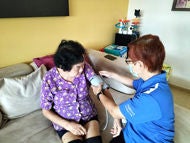What is - Utero-Vaginal Prolapse
A prolapse occurs when there is protrusion of an organ or structure beyond its normal position. In utero-vaginal prolapse, there is descent of the uterus and/or vagina. This is a common gynaecological condition but many women do not seek treatment because of embarrassment, or they are unaware that the condition can cause problems and that treatment is available. It is important to seek medical advice early as it can be treated.
Prolapse of the uterus can occur on its own. But it can also be associated with a protrusion of the anterior (front), or posterior (back) wall of the vagina, or both. In women who have had their uterus removed, prolapse of the vagina can occur after surgery. The degree of prolapse can vary from a very mild descent of the pelvic organs, to a severe descent in which the uterus, part of the bladder and part of the rectum (back passage) protrudes through the vaginal opening.
Symptoms of Utero-Vaginal Prolapse
Some women with a very mild degree of prolapse may not have any symptoms at all. However most women with significant prolapse may experience some of the followings:
- Dragging sensation or discomfort in the lower abdomen or pelvis
- Sensation of swelling or fullness in the vagina
- Backache
- Vaginal discharge or bleeding
- Difficulty in passing motion or urine
- Urinary symptoms which include passing urine more frequently, a sensation of incomplete emptying of the bladder or leakage of urine during coughing, sneezing and straining.
Many of the above symptoms are relieved when lying down. The symptoms are worse in the evening and better in the morning.
Utero-Vaginal Prolapse - How to prevent
Prevention may not always be successful. However certain measures can be taken to reduce the chances of developing utero-vaginal prolapse, or to prevent a prolapse from getting worse.
- In pregnancy: Pelvic floor exercises. (Your doctor may be able to advise you on this, or refer you to a physiotherapist).
- During labour: Avoid bearing down (pushing) before the cervix is fully dilated
- After delivery: Avoid bearing down efforts and constipation. Continue pelvic floor exercises early.
- After menopause: Hormone replacement may be helpful. (Your doctor will be able to advise you on this). Avoid prolonged standing, heavy lifting and chronic cough. Restart pelvic floor exercises daily.
What Are The Complications If Left Untreated?
These are generally preventable and occur only with longstanding untreated cases of moderate or severe utero-vaginal prolapse.
- Ulceration and infection of the cervical and vaginal skin
- Bleeding of the lower tract
- Thickening of the skin of the cervix
- Obstruction to urine flow and retention of urine leading to back pressure effects on the kidneys
- Urinary tract infection
- Worsening prolapse
Utero-Vaginal Prolapse - Causes and Risk Factors
What Causes The Prolapse?
This is due to a weakness in the supporting tissues of the uterus and vagina. The common factors leading to this are:
- Pregnancy & Childbirth: When there can be excessive stretching of the tissues
- After menopause: When a relative lack of female hormones can lead to thinning and weakening of the tissues
In addition, any condition that leads to an increase in the pressure in the abdominal cavity (e.g. chronic cough, constipation or heavy lifting) can aggravate the prolapse.
Diagnosis of Utero-Vaginal Prolapse
What Can I Expect During The Examination?
In order for the gynaecologist to advise you on the management of your condition, it will be necessary to take a detailed history and make a proper assessment of the degree of prolapse. This will involve an examination with you lying on your side and then on your back. You may be asked to cough and to bear down. Computerised testing of the bladder may also be performed to test for urinary leakage.
Treatment for Utero-Vaginal Prolapse
What Forms Of Treatment Are Available?
Non-Surgical Treatment
Once utero-vaginal prolapse has occurred, spontaneous recovery is not possible. There are many different types of vaginal pessaries available which can be inserted into the vagina to support the prolapse and temporarily relieve the symptoms. This type of treatment is not a cure and is used in cases when surgery is not suitable. Regular examinations are necessary to change the pessary and to check for complications such as ulceration or bleeding. Any aggravating factors such as chronic cough will need to be treated. You may be prescribed an estrogen containing cream to apply to the vagina if you are menopausal.
Surgical Treatment
Surgery is curative for utero-vaginal prolapse. The principles of surgery are to correct the supportive defects and restore the normal anatomy and sexual function. This may include removal of the uterus (hysterectomy), hitching up the bladder or vagina, or repair and 'tightening' of the vagina. Depending on the condition, surgery may be performed either through the vagina or through the abdomen. Your doctor will be able to discuss with you and advise you on the appropriate surgery.
Contributed by
The information provided is not intended as medical advice. Terms of use. Information provided by SingHealth.
Condition Treated At
Department
Obstetrics & Gynaecology
Department
Obstetrics and Gynaecology (O&G) Centre
Department
Pelvic Floor Disorders Service
Department
Pelvic Floor Disorder
Department
Urology
Department
Obstetrics and Gynaecology
Department
Urogynaecology Centre
Get to know our doctors at SingHealth Hospitals in Singapore.
Get to know our doctors at SingHealth Hospitals in Singapore. here.




















